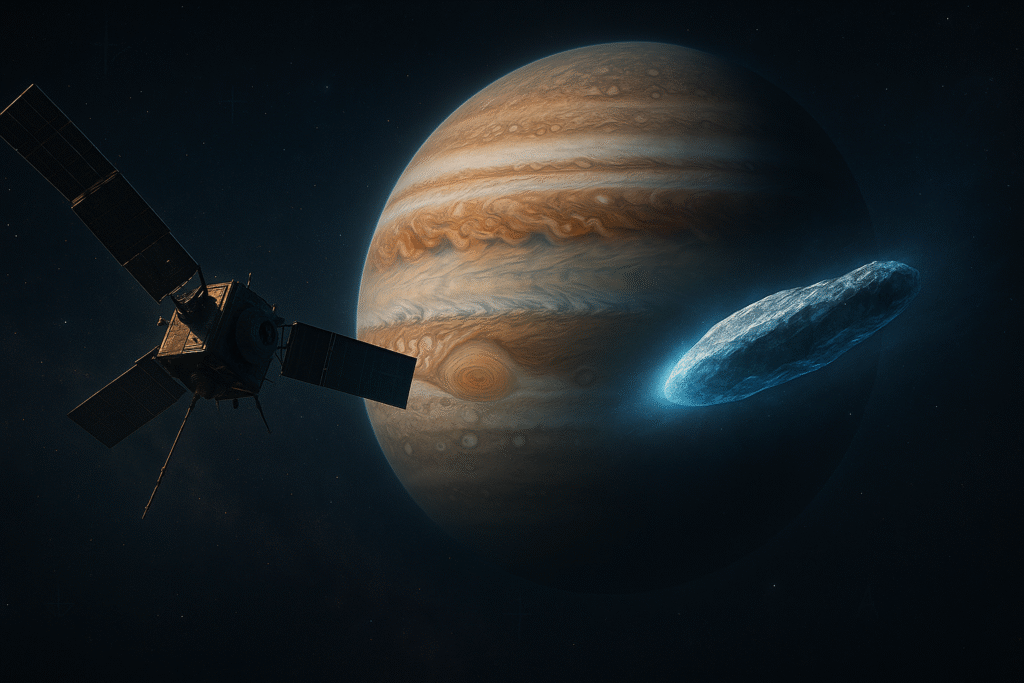Slug: juno-vs-3i-atlas-intercept-attempt
Excerpt: Harvard scientists propose reactivating the Juno spacecraft to intercept 3I/ATLAS—an interstellar visitor passing near Jupiter. Could this mission reveal an alien probe?
Tags: 3I/ATLAS, Juno spacecraft, interstellar object, alien probe, Avi Loeb, Harvard, Jupiter, Oberth maneuver, ʻOumuamua, space mysteries, NASA mission, alien intelligence
A New Hope for Contact: Intercepting an Interstellar Visitor
In a bold proposal published by Harvard astrophysicist Avi Loeb, a team of researchers suggests a historic first: reactivating NASA’s Juno spacecraft, currently orbiting Jupiter, to intercept the third known interstellar object, 3I/2023 A3 (a.k.a. 3I/ATLAS).
This unprecedented mission could offer humanity its first close-up look at a traveler from another star system—and possibly, something not of this Earth.
Juno’s Second Life: From Jupiter to the Interstellar Frontier
Launched in 2011, Juno was designed to study Jupiter’s composition, magnetic field, and mysterious moons like Europa and Ganymede. Since entering Jupiter’s orbit in 2016, Juno has accomplished its mission with remarkable efficiency, gliding through space without relying on its main engines since 2017.
Now, scientists are proposing to reactivate those dormant engines to redirect Juno toward a rendezvous with 3I/ATLAS as it passes near Jupiter in March 2026. This daring maneuver would require executing a precise Oberth maneuver—a slingshot acceleration using Jupiter’s gravity—to close the gap with the interstellar object.
According to Loeb:
“This is an extraordinary opportunity to get close to a visitor from another star and directly test whether it is natural or artificial in origin.”
Why Target 3I/ATLAS? The Strange Trajectory of an Interstellar Visitor
Discovered by the ATLAS survey in 2023, 3I/ATLAS has already drawn attention not just for its speed and hyperbolic orbit—but for its curiously aligned trajectory. It will cross the plane of the Solar System and pass close to three major planets: Venus, Mars, and Jupiter.
To many, this might be mere coincidence. But to some scientists—Loeb among them—it raises an eyebrow.
Could it be intentional? A route plotted by an extraterrestrial intelligence to gather data on our solar system, while avoiding Earth?
Avoiding Earth: A Sign of Intelligent Intent?
One of the most intriguing aspects of 3I/ATLAS is that it will not come anywhere near Earth during its closest approach. In fact, it will be more than 1 astronomical unit (AU) away—farther than the Earth is from the Sun.
If this were an alien probe, bypassing Earth could be a strategic move. Perhaps, as Loeb suggests, an advanced civilization already knows we’re here—and prefers not to interfere directly.
Instead, it could be conducting a quiet survey of our planetary system, passing close to key bodies while avoiding contact.
That’s not just science fiction. It’s a hypothesis based on trajectory and timing—one that requires empirical investigation.
Oumuamua, Borisov, and Now ATLAS: The Interstellar Mystery Grows
Before 3I/ATLAS, there were two others:
- ʻOumuamua (1I/2017 U1): The first known interstellar object, which exhibited no cometary tail and accelerated mysteriously—sparking debate over its origin.
- 2I/Borisov: A more typical interstellar comet, displaying features scientists expected from such objects.
Now enters 3I/ATLAS. If intercepted, it could finally provide clarity: is it a comet like Borisov—or a non-natural object like some suspect ʻOumuamua might have been?
The Mission Proposal: What Juno Could Discover
If the maneuver is approved, September 2025 would mark the start of Juno’s redirection. The flyby of 3I/ATLAS would occur around March 2026. Key objectives of the mission would include:
- High-resolution imaging: Determine shape, surface structure, and rotation.
- Spectroscopic analysis: Identify chemical composition, trace metals, or artificial materials.
- Thermal and magnetic data: Check for unnatural emissions or energy sources.
Even a brief encounter could yield data that surpasses everything we’ve learned from telescopic observations alone.
The Challenge: Fuel, Timing, and Green Lights
There’s a catch, of course. Juno has limited fuel reserves. But that’s exactly why the Oberth maneuver is so critical—it allows the probe to gain speed efficiently by using Jupiter’s gravity to slingshot in the direction of 3I/ATLAS.
According to calculations, it’s feasible—barely. But approval is needed. If NASA gives the green light, Juno’s thrusters could fire up again after 8 years of silence, pushing it onto a new trajectory that could change space exploration forever.
Scientific Skepticism vs. Cosmic Curiosity
While the mainstream scientific consensus still favors the natural origin theory—labeling 3I/ATLAS a typical interstellar comet—the proposal to intercept it shows how serious the alternative hypothesis is being taken.
Avi Loeb, often a controversial figure, continues to challenge assumptions with data-driven reasoning. His Galileo Project is dedicated to the scientific search for evidence of extraterrestrial technologies.
In his own words:
“If we miss this opportunity, we may regret it later—when we discover we were being watched all along.”
Conclusion: Don’t Miss the Moment
3I/ATLAS may be just another comet. Or it may be something much more significant.
We may never know—unless we act now.
With Juno already in the right neighborhood, we have a once-in-a-lifetime chance to intercept the unknown, test our theories, and perhaps, rewrite human history.
It’s a question not just of science—but of courage and curiosity.
Will we dare to chase it?

Woah! I’m really loving the template/theme of this blog. It’s simple, yet effective. A lot of times it’s very difficult to get that “perfect balance” between user friendliness and appearance. I must say you have done a fantastic job with this. Additionally, the blog loads super quick for me on Opera. Superb Blog!